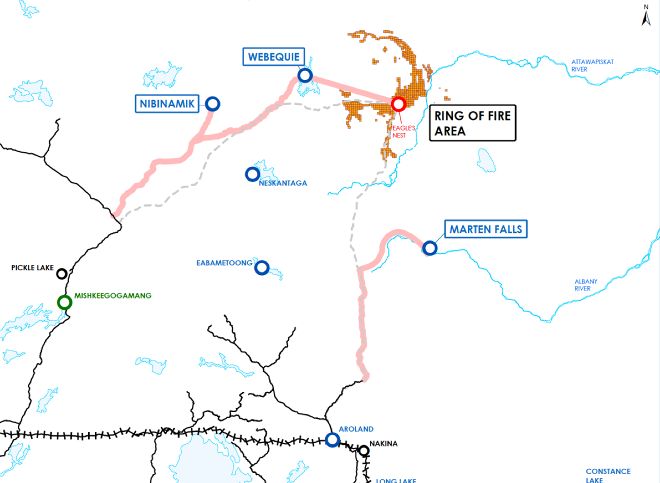One isolated First Nation community near the Ring of Fire declares that a year-round access road will bring a "prosperous, sustainable, and more inclusive future for its elders, youth and families."
In an Aug. 31 news release, Marten Falls said the time has come to finally be connected to the provincial highway system after "years of negotiating and planning" for a community access road.
Premier Kathleen Wynne's two-corridor Ring of Fire road proposal unveiled in Thunder Bay on Aug. 21 was initially being celebrated as a breakthrough in finally making progress on development in the stalled Far North mineral camp.
Within days, the chiefs of four of the five communities closest to the Ring of Fire either backtracked on their support for a east-west shared community/industrial road, or vowed to stop its planned construction in early 2019.
But Marten Falls is signaling it's only too willing to work with the province in planning and building a north-south road.
"Marten Falls sees this as an opportunity for present and future generations of families who want to live in the community and be gainfully and proudly employed. At the same time, this is also an opportunity for other regional and remote First Nations to connect with the north-south corridor and participate in related socioeconomic benefits," said the community release.
The remote community of 330 is located 170 kilometres northeast of Nakina.
According to a rudimentary map provided by the province, the access road to Marten Falls follows a path that begins in the Nakina-Aroland area and goes halfway to the Ring of Fire before doglegging to the right and into community.
The southern portion appears to follow a contested route once staked by KWG Resources for a future mining railroad.
The community said isolation has contributed to poverty, drug issues and various other social and economic problems. Having a year-round road means food security, better housing, and education and employment opportunities that have been denied to them.
Climate change has shortened the winter road season - when construction material, fuel, and other heavy loads are hauled in - and is "no longer an option."
Only one daily flight is available to Nakina, compared to other remote communities with more frequent service to major centres like Thunder Bay, the community said.
Noront Resources, the leading mine development player in the Ring, views the Marten Falls access road as the "first leg" of an eventual corridor to bring chromite out for processing as mining operations expand in the Far North in the years to come.
Marten Falls responds industrial access will eventually come once environmental concerns are addressed and agreements are struck giving them more control in the management of the corridor.
"In time, the north-south route would provide access to the chromite deposits in Marten Falls' traditional lands but planning, feasibility and environmental work on this portion of the road to the Ring of Fire will start now."
Marten Falls said it will have a major say in working with the province in planning the route "for the next year or more, and (the process) could be expedited to connect the Ring of Fire as required."
The community revealed it "only started work on road options with the province late last year."
Consultation with other communities will be part of this process to get their input in the road development.
"This is an unprecedented opportunity for collaborative planning and development between the First Nation, government and industry. Marten Falls welcomes collaboration where it can create value for all," said the release.
Marten Falls was geographically off the path to be included in a $785,000 federally and provincially-back study in 2015 to decide on the routing for a shared east-west community and industrial road.
An east-west road, that basically followed the established winter road network, was considered a cheaper alternative to reach the Ring of Fire than a north-south corridor, which would have to cross major river systems.
Two of the communities on the east-west side now contend Wynne's plan is only for an access route to their settlements, not the Ring of Fire.




